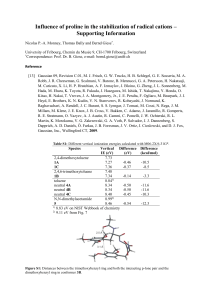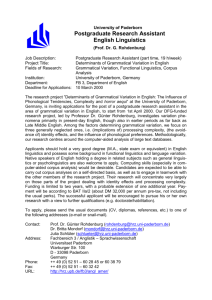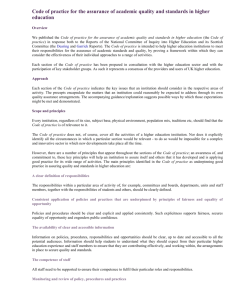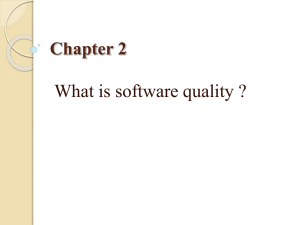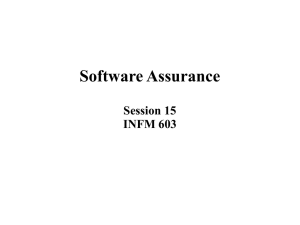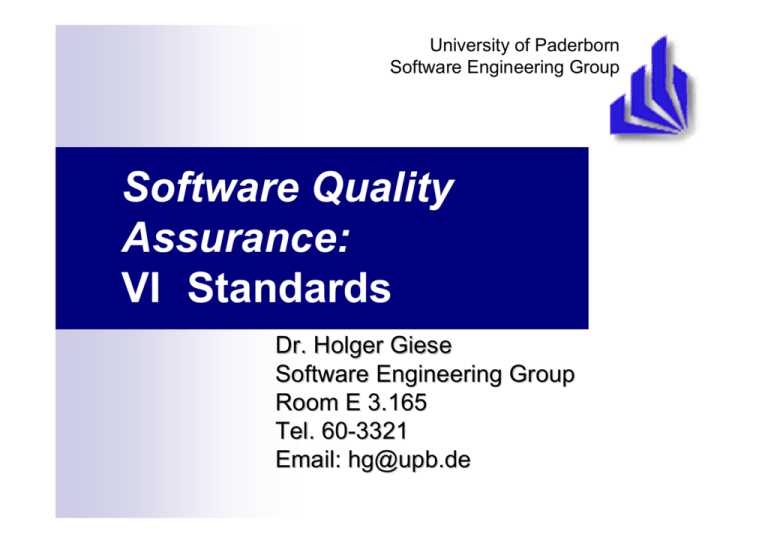
University of Paderborn
Software Engineering Group
Software Quality
Assurance:
VI Standards
Dr. Holger Giese
Software Engineering Group
Room E 3.165
Tel. 60-3321
Email: hg@upb.de
University of Paderborn
Software Engineering Group
Outline
I
II
III
IV
V
VI
VII
Introduction
Software Life Cycle
Quality Control
Infrastructure
Management
Standards
Conclusion & Summary
Dr. Holger Giese
WS04/05 – Software Quality Assurance – VI Standards
VI-2
University of Paderborn
Software Engineering Group
VI Standards
VI.1 Introduction
VI.2 Quality Management Standards
VI.3 Process Standards
VI.4 Discussion & Summary
VI.5 Bibliography
Dr. Holger Giese
WS04/05 – Software Quality Assurance – VI Standards
VI-3
University of Paderborn
Software Engineering Group
VI.1 Introduction
[Galin2004]
The benefits of use of standards:
The ability to apply methodologies and procedures
of the highest professional level.
Better mutual understanding and coordination
among development teams but especially between
development and maintenance teams.
Greater cooperation between the software
developer and external participants in the project.
Better understanding and cooperation between
suppliers and customers, based on the adoption of
standards as part of the contract.
Dr. Holger Giese
WS04/05 – Software Quality Assurance – VI Standards
VI-4
University of Paderborn
Software Engineering Group
[Galin2004]
Classes of Standards
Characteristics
Quality Management
Standards
Project Process
Standards
The target unit
Management of software
development and/or
maintenance and the
specific SQA units
Organization of SQA
systems, infrastructure
and requirements
A software development
and/or maintenance
project team
Standard’s
objective
“What” to achieve
“How” to perform
Standard's goal
Assuring supplier’s
software quality and
assessing its software
process capability
Assuring the quality of a
specific software project’s
products
The main focus
Dr. Holger Giese
Methodologies for carrying
out software development
and maintenance projects
WS04/05 – Software Quality Assurance – VI Standards
VI-5
University of Paderborn
Software Engineering Group
[Galin2004]
Organizations involved in
SQA Standards Development
Most prominent developers of SQA standards:
IEEE (Institute of Electric and Electronic
Engineers) Computer Society
ISO (International Standards Organization)
DOD (US Department of Defense)
ANSI (American National Standards Institute)
IEC (International Electrotechnical Commission)
EIA (Electronic Industries Association)
Dr. Holger Giese
WS04/05 – Software Quality Assurance – VI Standards
VI-6
University of Paderborn
Software Engineering Group
VI.2 Quality Management Standards
[Galin2004]
The scope of quality management standards
ISO 9001 and ISO 9000-3
Certification according to ISO 9000-3
Capability Maturity Models
The SPICE project and the ISO/IEC 15504
software process assessment standard
Dr. Holger Giese
WS04/05 – Software Quality Assurance – VI Standards
VI-7
University of Paderborn
Software Engineering Group
The Scope of Quality
Management Standards
[Galin2004]
Certification standards:
Enable a software development organization to
demonstrate consistent ability to assure acceptable quality
of its software products or maintenance services.
Certification is granted by an external body.
Serve as an agreed-upon basis for customer and supplier
evaluation of the supplier’s quality management system.
Accomplished by performance of a quality audit by the
customer.
Support the organization's efforts to improve its quality
management system through compliance with the
standard’s requirements.
Dr. Holger Giese
WS04/05 – Software Quality Assurance – VI Standards
VI-8
University of Paderborn
Software Engineering Group
The Scope of Quality
Management Standards
[Galin2004]
Assessment standards:
Serve organizations as a tool for self-assessment of
their ability to carry out software development projects.
Serve for improvement of development and
maintenance processes by application of the standard
directions
Help purchasing organizations determine the
capabilities of potential suppliers.
Guide training of assessor by delineating qualifications
and training program curricula.
Dr. Holger Giese
WS04/05 – Software Quality Assurance – VI Standards
VI-9
University of Paderborn
Software Engineering Group
ISO 9000-3 Principles
[Galin2004]
Customer focus
Leadership
Involvement of people
Process approach
System approach to management
Continual improvement
Factual approach to decision making
Mutually supportive supplier relationships
Dr. Holger Giese
WS04/05 – Software Quality Assurance – VI Standards
VI-10
University of Paderborn
Software Engineering Group
ISO 9000-3: Requirements Classification
Requirement Subjects
Requirement Subjects
4. Quality management system
4.1 General requirements
4.2 Documentation requirements
5. Management responsibilities
5.1 Management commitments
5.2 Customer focus
5.3 Quality policy
5.4 Planning
5.5 Responsibility, authority and communication
5.6 Management review
6.1 Provision of resources
6.2 Human resources
6.3 Infrastructure
6.4 Work environment
7.1 Planning of product realization
7.2 Customer-related processes
7.3 Design and development
7.4 Purchasing
7.5 Production and service provision
7.6 Control of monitoring and measuring devices
8.1 General
8.2 Monitoring and measurement
8.3 Control of nonconforming product
8.4 Analysis of data
8.5 Improvement
6. Resource management
7. Product realization
8. Measurement, analysis and
improvement
[Galin2004]
Dr. Holger Giese
WS04/05 – Software Quality Assurance – VI Standards
VI-11
University of Paderborn
Software Engineering Group
ISO 9000-3: Certification Process
Organization requesting certification
[Galin2004]
The certifying organization
The
The
decision
decision
Planning
process
Planning
process
leading to leading
certification
to
certification
Development of the
organization’s
SQA
Development of
the
system
organization’s
SQA system
Organization’s quality
manual and SQA
Organization’s
procedures
quality manual and
SQA procedures
Review of the quality manual
and SQA procedures
I m ple m ent at ion
I m plem
entofa t ion of
orga niza
t ion’s
SQA
orga
nizat ion’s
syst
em
SQA syst em
Review of the
quality manual and
SQA procedures
Do the quality
manual and
procedures comply
with ISO 9000-3 ?
Do the quality
manual and
procedures
comply with
ISO 9000-3 ?
No
No
Yes
Performance audit of SQA
management
system
Yes
Carry out performance
improvements of SQA
management system
ISO 9000-3
certification
Dr. Holger Giese
Performance audit
of SQA management
Does the
No
system performance of
the
SQA system comply
with ISO 9000-3?
Yes
WS04/05 – Software Quality Assurance – VI Standards
VI-12
University of Paderborn
Software Engineering Group
Software Capability Maturity
Model (CMM)
[SWENET]
In the late 1980s, the Software Engineering
Institute (SEI), Carnegie Mellon University,
developed the SW-CMM (Software Capability
Maturity Model) to help organizations build
effective software engineering processes.
It has been widely adopted in industry, primarily by
large software development organizations.
Dr. Holger Giese
WS04/05 – Software Quality Assurance – VI Standards
VI-13
University of Paderborn
Software Engineering Group
CMM Assessment: Principles
Quantitative management methods increases the
organization's capability to control the quality and improve
the productivity.
Application of the five-level capability maturity model that
enables to evaluate the achievements and determine the
efforts needed to reach the next capability.
Generic process areas that define the “what” — not “how”
enables the model's applicability to a wide range of
implementation organizations:
It allows use of any life cycle model.
It allows use of any design methodology, development
tool and programming language.
It does not specify any particular documentation
standard.
[Galin2004]
Dr. Holger Giese
WS04/05 – Software Quality Assurance – VI Standards
VI-14
University of Paderborn
Software Engineering Group
SW-CMM Levels
Level
5: Optimizing
Focus
Continuous Process
Improvement
4: Managed
Product and Process
Quality
3: Defined
Engineering Process
2: Repeatable Project Management
1: Initial
Dr. Holger Giese
No Focus
[SWENET]
Decription
Continuous process improvement is enabled by
quantitative feedback from the process and from
piloting innovative ideas and technologies.
Detailed measures of the software process and
product quality are collected. Both the software
process and products are quantitatively understood
and controlled.
The software process for both management and
engineering activities is documented, standardized,
and integrated into a standard software process for
the organization. All projects use an approved,
tailored version of the organization's standard
software process for developing and maintaining
software.
Basic project management processes are
established to track cost, schedule, and
functionality. The necessary process discipline is in
place to repeat earlier successes on projects with
similar applications.
Project success primary depends on individuals
and their heroics.
WS04/05 – Software Quality Assurance – VI Standards
VI-15
University of Paderborn
Software Engineering Group
SW-CMM Assessment
[SWENET]
1342 organizations [SEMA 2003]
Dr. Holger Giese
WS04/05 – Software Quality Assurance – VI Standards
VI-16
University of Paderborn
Software Engineering Group
Time Required to Progress
to the Next CMM Level
Capability level
transition
Level 1 to level 2
[Galin2004]
Mean time
No. of
(months) organizations
24
125
Level 2 to level 3
21.5
124
Level 3 to level 4
33
18
Level 4 to level 5
18
19
Source: [Gartner2001]
Dr. Holger Giese
WS04/05 – Software Quality Assurance – VI Standards
VI-17
University of Paderborn
Software Engineering Group
[Galin2004]
Project resources distribution
by CMM capability level
Percentage of project resources
CMM capability
level
Original work
Reworking
Testing and quality
assurance
1
34
41
25
2
55
18
27
3
67
11
22
4
76
7
17
see Raytheon [Galin2004]
Dr. Holger Giese
WS04/05 – Software Quality Assurance – VI Standards
VI-18
University of Paderborn
Software Engineering Group
Versions of CMMI (Capability
Maturity Model Integration)
CMMI-SE/SW
CMMI-SE/SW/IPPD/SS
System Engineering CMM (SE-CMM)
Software Engineering CMM (SW-CMM)
System Engineering CMM (SE-CMM)
Software Engineering CMM (SW-CMM)
Integrated Product/Process Development (IPPD-CMM)
Supplier Sourcing
CMMI-SE/SW/IPPD
System Engineering CMM (SE-CMM)
Software Engineering CMM (SW-CMM)
Integrated Product/Process Development (IPPD-CMM)
[Galin2004]
Dr. Holger Giese
WS04/05 – Software Quality Assurance – VI Standards
VI-19
University of Paderborn
Software Engineering Group
ISO/IEC 15504 Process
Assessment Model
Level 5: Optimizing
process
Level 4: Predictable process
Level 3: Established processes
Process change
Continuous improvement
Measurement
Process control
Process definition
Process resource
Performance management
Work product management
Process performance
No requirements
Dr. Holger Giese
[Galin2004]
Level 2: Managed process
Level 1: Performed process
Level 0: Incomplete
WS04/05 – Software Quality Assurance – VI Standards
VI-20
University of Paderborn
Software Engineering Group
ISO/IEC 15504: Principles
[Galin2004]
Harmonize the many existing “independent”
assessment methodologies by providing a
comprehensive framework model (“what” has to be
accomplished rather than “how” it has to be done).
Be universal to serve all or almost all categories of
software suppliers, customers and software categories.
Be highly professional.
Aim at reaching international acceptance as world
standard. To save suppliers' resources by eliminating
the need to perform several different capability
assessments in response to different customer
requirements.
Dr. Holger Giese
WS04/05 – Software Quality Assurance – VI Standards
VI-21
University of Paderborn
Software Engineering Group
SPICE Project Rating & Levels
[Galin2004]
Grade
Rating
Achievements
F (fully)
86-100%
Systematic and complete or almost complete
performance of process attributes.
L (largely)
51-85%
Significant achievements and systematic
approach are evident. Some areas of low
performance exist
P (partially)
16-50%
Some achievements and aprtial adoptions of
systematic approach are evident. Other
aspects of process attributes are uncontrolled
N (not)
0-15%
Little or no achievements of the process
attributes
F or L for the process attributes of the level
and F for all preceding levels
Dr. Holger Giese
WS04/05 – Software Quality Assurance – VI Standards
VI-22
University of Paderborn
Software Engineering Group
Goals of the SPICE Project Trials
[Galin2004]
To validate the ISO/IEC 15504 model's
conformity with current standards.
To verify its usability in determining whether
software satisfies user requirements.
To gain experience in applying the ISO/IEC
15504 model.
Dr. Holger Giese
WS04/05 – Software Quality Assurance – VI Standards
VI-23
University of Paderborn
Software Engineering Group
VI.3 Process Standards
IEEE software engineering standards:
The structure and content of IEEE software
engineering standards
IEEE/EIA Std. 12207
– Software life cycle processes
IEEE Std. 1012
– Verification and validation
IEEE Std. 1028
– Reviews
Dr. Holger Giese
WS04/05 – Software Quality Assurance – VI Standards
VI-24
University of Paderborn
Software Engineering Group
Classes of IEEE Standards
[Galin2004]
A Conceptual standards.
Guiding principles and overall approach
IEEE 1061 – Software Quality Metrics Methodology
IEEE/EIA 12207.0 — Information Technology Software Life Cycle Processes
B Prescriptive standards of conformance.
Requirements to which a software developer must conform.
·
IEEE 829 — Software Test Documentation
IEEE 1012 – Software Verification And Validation
IEEE 1028 – Software Reviews
C Guidance standards.
Implementation of class B standards.
IEEE 1233 – Guide for Developing System Requirement Specifications
IEEE/EIA 12207.1 – Guide, Information technology – Software Life Cycle Processes
– Life Cycle Data
Dr. Holger Giese
WS04/05 – Software Quality Assurance – VI Standards
VI-25
University of Paderborn
Software Engineering Group
Purpose of IEEE/EIA Std 12207
To establish an internationally recognized
model of common software life cycle
processes that can be referenced by the
software industry worldwide.
To promote understanding among business
parties by application of commonly
recognized processes, activities and tasks.
[Galin2004]
Dr. Holger Giese
WS04/05 – Software Quality Assurance – VI Standards
VI-26
University of Paderborn
Software Engineering Group
[Galin2004]
Tailoring
IEEE/EIA Std 12207
Software life cycle processes
Acquisition
Pr
im
ar
yp
Development
ro
Operation
ce
ss
Maintenance
es
pr
oc
e
ng
or
ti
pp
Su
Or
s
sse
Configuration management
Quality assurance
Verification
Validation
Joint review
Audit
Problem resolution
ga
ni
za
t io
na
l
Improvement
Training
Documentation
pr
oc
e
Infrastructure
s
Management
Software
l if e c y c l e
sse
Supply
Source: IEEE (1992). From IEEE Std 10 45-19992. Copyright 1992 IEEE. All rights reserved.
Dr. Holger Giese
WS04/05 – Software Quality Assurance – VI Standards
VI-27
University of Paderborn
Software Engineering Group
IEEE/EIA Std 12207.0 Concepts
General concepts
Applicability of the standard in general and its adaptation by tailoring
Applicability for all participants in the software life cycle
Flexibility and responsiveness to technological change
Software links to the system
TQM consistency
No certification requirements
Baselining
Task-related concepts
Responsibility for activities and tasks
Modularity of components of software life cycle
Levels of required conformance
Nature of evaluation task
[Galin2004]
Dr. Holger Giese
WS04/05 – Software Quality Assurance – VI Standards
VI-28
University of Paderborn
Software Engineering Group
Purpose of IEEE Std 1012
[Galin2004]
Establish a common framework for V&V
activities and tasks for all software life cycle
processes.
Define V&V requirements, including their
inputs and outputs.
Define software integrity levels and the
appropriate V&V tasks.
Define the content of a SVVP (software V&V
Plan) document.
Dr. Holger Giese
WS04/05 – Software Quality Assurance – VI Standards
VI-29
University of Paderborn
Software Engineering Group
IEEE Std 1012 Concepts
Broad definition of V&V activities
Software integrity levels and their V&V requirements
Prescriptive requirements
[Galin2004]
Detailed description of the performance methodology.
Required inputs.
Required outputs.
Definition of integrity levels for which performance of the task is not
mandatory.
Optional V&V tasks to be performed during selected life cycle process.
Independence of V&V activities
Compliance and compatibility with international standards
Special characteristics of reusable software V&V
Application of V&V metrics
Quantitative criteria for V&V tasks
Dr. Holger Giese
WS04/05 – Software Quality Assurance – VI Standards
VI-30
University of Paderborn
Software Engineering Group
Processes Covered by IEEE Std 1012
(1)
(2)
(3)
(4)
(5)
(6)
Management
Acquisition
Supply
Development
Operation
Maintenance
A three level tree architecture:
Processes (each includes 1-6 activities)
Activities (each includes 3-10 tasks)
Tasks
[Galin2004]
Dr. Holger Giese
WS04/05 – Software Quality Assurance – VI Standards
VI-31
University of Paderborn
Software Engineering Group
IEEE Std 1028
[Galin2004]
Purpose: to define systematic review procedures
that are:
Applicable for reviews performed throughout the
software life cycle
Conform with the review requirements defined by
other standards
Concepts:
High formality
Follow-up of corrections
Compliance with international and IEEE standards
Dr. Holger Giese
WS04/05 – Software Quality Assurance – VI Standards
VI-32
University of Paderborn
Software Engineering Group
IEEE Std 1028: Types of Reviews
Management
reviews
Technical reviews
Inspections
Walkthroughs
Audits
[Galin2004]
Dr. Holger Giese
WS04/05 – Software Quality Assurance – VI Standards
VI-33
University of Paderborn
Software Engineering Group
[Galin2004]
Review Document Structure:
(1)
(2)
(3)
(4)
(5)
(6)
(7)
(8)
(9)
Introduction
Responsibilities The responsibilities of the participants in the
review.
Input Mandatory and optional data items.
Entry criteria Common criteria: a. a statement of the review's
objectives. b. Availability of the required input data.
Procedure Required to include: management preparations,
planning, team preparation, examination of the products, follow up
of corrections.
Exit criteria What must be accomplished before the review can be
concluded.
Output items
Data collection recommendations To be used to study the
effectiveness and efficiency of current practices.
Improvements Formulate improved procedures, checklists and
development processes.
Dr. Holger Giese
WS04/05 – Software Quality Assurance – VI Standards
VI-34
University of Paderborn
Software Engineering Group
VI.4 Discussion & Summary
The benefits of using of standards is the ability to apply methodologies
and procedures of the highest professional level that facilitate better
mutual understanding and coordination
among development teams but especially between development and
maintenance teams.
between the software developer and external participants in the
project.
between suppliers and customers, based on the adoption of
standards as part of the contract.
Quality Management Standards targeting the Management of
software development and/or maintenance and the specific SQA units
and focus on “What” to achieve.
Project Process Standards is targeting a software development and/or
maintenance project team and focus on “How” to perform
Dr. Holger Giese
WS04/05 – Software Quality Assurance – VI Standards
VI-35
University of Paderborn
Software Engineering Group
VI.5 Bibliography
[DeMarco1982]
[Galin2004]
[Gartner2001]
[SEMA 2003]
Dr. Holger Giese
T. De Marco, Controlling Software Projects:
Management, Measurement and Estimation, Yourdon
Press, New York, 1982.
D. Galin, Software Quality Assurance: From theory to
implementation. Harlow, England: Pearson Addison
Wesley, 2004.
Gartner Inc. “Describing the Capability Maturity Model”,
Measure, Special Edition 2001, Gartner Inc.
http://www.gartner.com/measurements
Software Engineering Measurement and Analysis,
Process Maturity Profile: Software CMM, CBA IPI and
SPA Appraisal Results, 2003 Mid-Year Update,
Software Engineering Institute, Carnegie Mellon
University September 2003,
http://www.sei.cmu.edu/sema/pdf/SWCMM/2003sepSwCMM.pdf.
WS04/05 – Software Quality Assurance – VI Standards
VI-36



